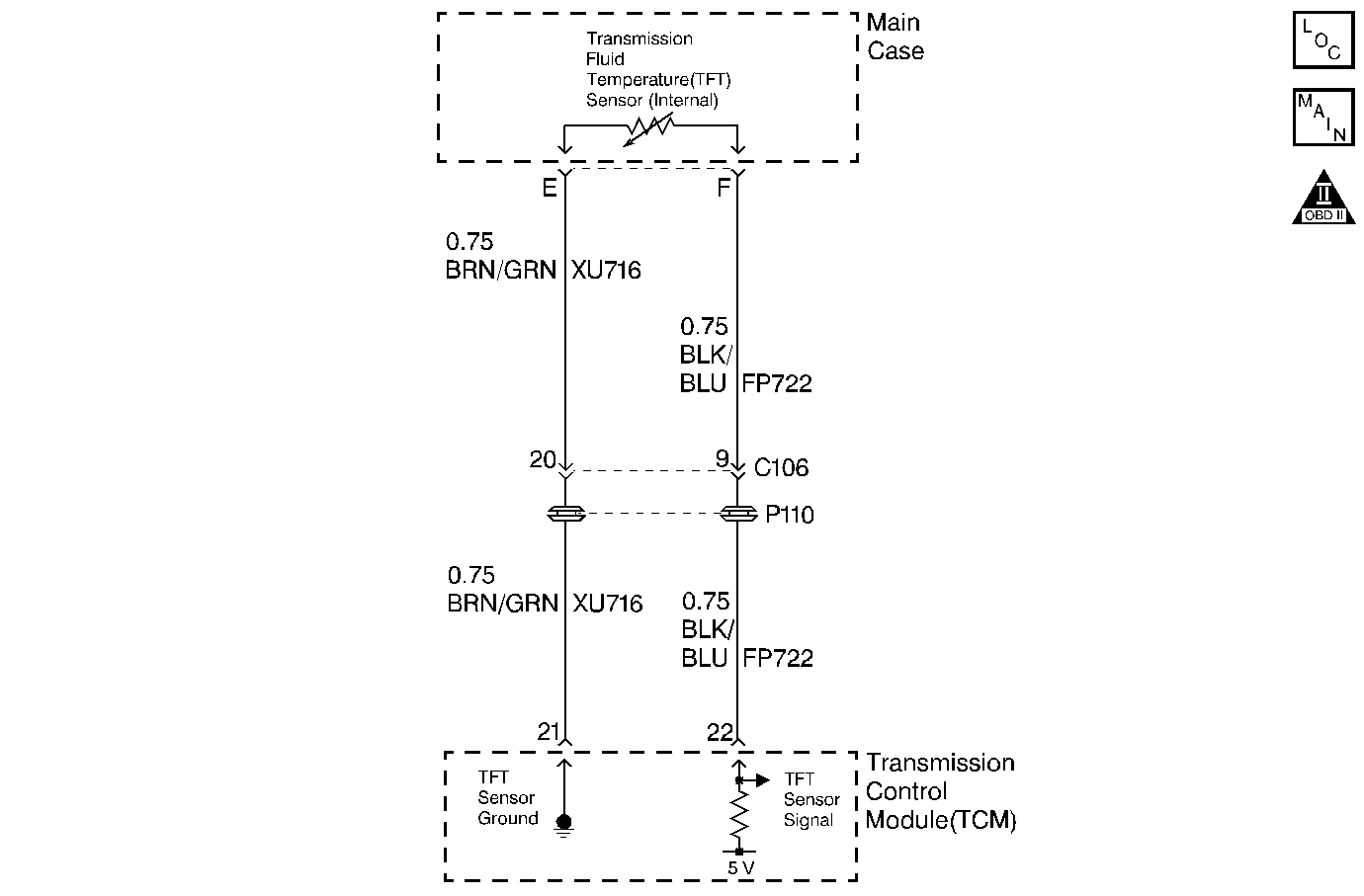
Circuit Description
The automatic transmission fluid temperature (TFT) sensor is part of the 4L30-E automatic transmission internal wiring harness assembly. The TFT sensor is a thermistor, which is a resistor that changes value when the temperature changes. The sensor has a negative-temperature coefficient. This means that as the temperature increases, the resistance decreases, and as the temperature decreases, the resistance increases. The transmission control module (TCM) supplies a 5-volt reference signal to the sensor and measures the voltage drop in the circuit. When the transmission fluid is cold, the sensor resistance is high and the TCM detects high signal voltage. As the fluid temperature increases, the resistance decreases, which pulls down the signal voltage.
If the TCM detects an open in the TFT sensor or signal circuit, then DTC P0713 sets. DTC P0713 is a type C DTC.
Condition for Running the DTC
The ignition is ON.
Condition for Setting the DTC
TFT is above 4.35 Volts for 20 seconds.
Action Taken When the DTC Sets
| • | The TCM flashes the sport mode lamp. |
| • | The ECM records the operating conditions when the Conditions for Setting the DTC are met. The ECM records this information as Failure Records. |
| • | The TCM stores DTC P0713 in TCM history. |
| • | The TCM uses a default temperature value of 130°C (266°F). |
| • | The TCM freezes shift adapts from being updated. |
Conditions for Clearing the STL/DTC
| • | The TCM stops flashing the sport mode lamp as soon as the fault is no longer present. |
| • | A scan tool can clear the DTC. |
| • | The TCM clears the DTC from TCM history if the vehicle completes 40 warm-up cycles without a non-emission-related diagnostic fault occurring. |
| • | The TCM cancels the DTC default actions when the ignition switch is OFF long enough in order to power down the TCM. |
Test Description
The numbers below refer to the step numbers on the Diagnostic Table.
-
This step tests for higher than normal circuit voltage which may also damage the TFT sensor.
-
This step simulates a TFT sensor DTC P0712. If the PCM recognizes the low signal voltage (high temperature), the PCM and the wiring are OK.
-
This step verifies a problem in the TFT sensor circuit.
Step | Action | Value(s) | Yes | No |
|---|---|---|---|---|
1 | Did you perform Powertrain On Board Diagnostic (OBD) System Check - Automatic Transmission ? | -- | Go to Powertrain On Board Diagnostic (OBD) System Check - Automatic Transmission | |
2 |
Important: Record the Failure Records before clearing the DTCs. Using the Clear Info function erases the Failure Records from the ECM and the TCM. Does the scan tool display a TFT sensor signal voltage greater than the specified value? | 4.35 V | Go to Intermittent Conditions in Engine Controls | |
Refer to Test Description for information about Step 3. Does the scan tool display a TFT voltage greater than the specified value? | 5.1 V | |||
4 |
Is the voltage within the specified value? | 4.8-5.2 V | ||
Is the Scan Tool TFT sensor signal voltage less than the specified value? | 0.09 V | |||
Is the resistance within the specified values? | Refer to Transmission Fluid Temperature Sensor Specifications | Go to Intermittent Conditions in Engine Controls | ||
7 | Replace the AT main case wiring harness assembly. Refer to Control Valve Body . Is the action complete? | -- | -- | |
8 |
Caution: When you are performing service on or near the SIR components or the SIR wiring, you must disable the SIR system. Refer to Disabling the SIR System. Failure to follow the correct procedure could cause air bag deployment, personal injury, or unnecessary SIR system repairs. Inspect the Transmission Oil Temperature Sensor Low Reference (CKT XU716) for high resistance or an open. Refer to Circuit Testing in Wiring Systems. Did you find and correct a condition? | -- | ||
9 |
Caution: When you are performing service on or near the SIR components or the SIR wiring, you must disable the SIR system. Refer to Disabling the SIR System. Failure to follow the correct procedure could cause air bag deployment, personal injury, or unnecessary SIR system repairs. Inspect the Transmission Oil Temperature Sensor Signal circuit (CKT FP722) for a short to voltage B+. Did you find and correct a condition? | -- | ||
10 |
Caution: When you are performing service on or near the SIR components or the SIR wiring, you must disable the SIR system. Refer to Disabling the SIR System. Failure to follow the correct procedure could cause air bag deployment, personal injury, or unnecessary SIR system repairs. Inspect the Transmission Oil Temperature Sensor Signal circuit (CKT FP722) for high resistance or an open. Did you find and correct a condition? | -- | ||
11 | Replace the TCM. Refer to Transmission Control Module Replacement . Is the action complete? | -- | -- | |
12 | Perform the following procedure in order to verify the repair:
Does the Scan Tool display a TFT Sensor voltage less than the specified value? | 4.35 | System OK |
